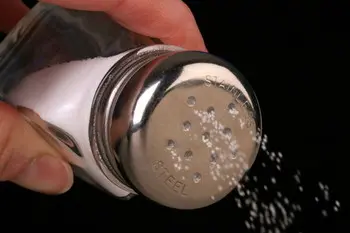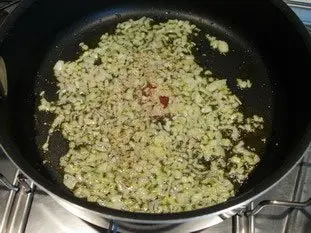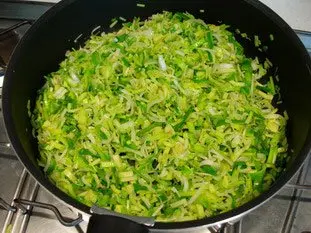This site uses only a few technical cookies necessary for its operation. By continuing to browse, you accept their use.
To find out more...
To find out more...
When should you salt?

In the kitchen, we salt very frequently, almost all the time, and we must be careful because this salt can influence the texture of what you are cooking.
I'm not going to talk about the amount of salt here, that's for another time, but rather about : When do you salt?
I'm not going to talk about the amount of salt here, that's for another time, but rather about : When do you salt?
17 K 4.5/5 (22 reviews)
Keywords for this post:SaltSaltTimeCookingLast modified on: August 13th 2019
When should you salt?
Let's imagine that you are going to prepare leeks. There are thousands of ways to do it, but one of the most classic is "sautéed".
By doing so, you will have a cooking that preserves the structure of the vegetable, and you avoid the excess of liquid at the bottom of your pan.
To sum up: When cooking vegetables or mushrooms, it is best to add salt only once the cooking is finished, to keep your vegetables in good condition.

How do you do it?
- You peel, wash, dry and slice your leeks
- You do the same thing with a shallot
- In a saucepan or a frying pan, you heat a littleoil or butter or clarified butter
- Once it's hot, you pour in the shallot, stir a little and add a little salt and pepper
Here is the first salt shaker, note that it is light, and concerns (for the moment) only the shallot, we continue...
- Cook the shallot, 1 minute maximum, it must not colour or turn brown (we say"without colouring")
- Add the leeks, stir well to mix, and do not add any salt.
Why not? Well, because the salt with its hygroscopic side, if you add it now, will "pump" the water out of the leeks, water that will end up at the bottom of the pan, and that you will have to remove later by overcooking.
Moreover, if the water is extracted from the leeks, they will become excessively soft and less appetizing, losing their beautiful green colour more easily. Let's continue... - You cook/sauté the leeks like this, uncovered, stirring from time to time, until they are soft to your taste, but still green
- And finally, off the heat, you add salt and pepper to taste

By doing so, you will have a cooking that preserves the structure of the vegetable, and you avoid the excess of liquid at the bottom of your pan.
To sum up: When cooking vegetables or mushrooms, it is best to add salt only once the cooking is finished, to keep your vegetables in good condition.
Lasts posts
Butter vs. grease
We often read in a recipe where a pastry is put into a mould that, just before pouring, the mould should be buttered or greased. But what's the difference between these 2 terms?December 1st 20257405
Getting out of the fridge early
Very often when you're cooking, you need to take food or preparations out of the fridge, to use them in the recipe in progress. There's nothing tricky about this: you just take them out of the fridge and use them, usually immediately, in the recipe. But is this really a good method?November 24th 20259855
Who's making the croissants?
When you look at a bakery from the outside, you naturally think that in the bakery, the bakers make the bread, and in the laboratory, the pastry chefs make the cakes. It's very often like that, with each of these professions having quite different ways of working, but sometimes there's also one...November 23th 2025889
Oven height
When we put a dish or cake in the oven, we naturally tend to put it on the middle shelf, and that's what we usually do. But in some cases, this position and height can be a little tricky, so let's find out why.October 8th 20252,5085
The importance of sieving
In recipes that use a fine powder (flour, powdered sugar, etc.), you'll often see the advice to sift before using it. To sift is to pass the powder in question through a sieve (a very fine strainer) before incorporating it into your recipe. It's often advice, but is it really useful?September 3rd 20257,3813
Other pages you may also like
How to avoid lumps
You've probably come across this unpleasant phenomenon where, when you try to incorporate an ingredient (usually a solid or powder) into a preparation (usually a liquid), the mixture doesn't mix properly and you end up with little "balls" or little lumps of the solid part that refuse to mix with the...October 9th 202022 K4.8
The so-called "nervous" meats
You've probably heard this before, we're talking about "nervous" meat, or meat with nerves, to describe what is indicated by the blue arrow on the left. This is a piece of beef, and what we call a nerve is not a nerve, it is in fact collagen (chemists sometimes call it a "collagen sink"), a...April 16th 202136 K4.5
Different kinds of pastry and dough
When cooking in general, and particularly in baking, we can make and use many different kinds of pastry and dough. All built on the same "base": flour - a powder to which we add fat, liquid or both to produce the dough which is then cooked. .November 6th 2012111 K 14.0
Fruits which can ruin your jelly
There are many ways of making a fruit mousse, but one of the simplest is to prepare a fruit jelly (basically a fresh fruit coulis with gelatine) and then mix this jelly before it sets completely with whipped cream. The result is perfect for filling a charlotte, for example. But do beware;...March 6th 201378 K4.0
The window-pane test in bread-making
The home bread-makers often ask themselves “Have I kneaded my dough long enough?” . A good question, as dough that is insufficiently kneaded will not rise properly or will fall flat when the top is slashed, which is very frustrating. To know when the dough is ready, one can rely on the length...June 16th 202196 K 23.9
Post a comment or question
Follow this page
If you are interested in this page, you can "follow" it, by entering your email address here. You will then receive a notification immediately each time the page is modified or a new comment is added. Please note that you will need to confirm this following.
Note: We'll never share your e-mail address with anyone else.
Alternatively: you can subscribe to the mailing list of cooling-ez.com , you will receive a e-mail for each new recipe published on the site.









